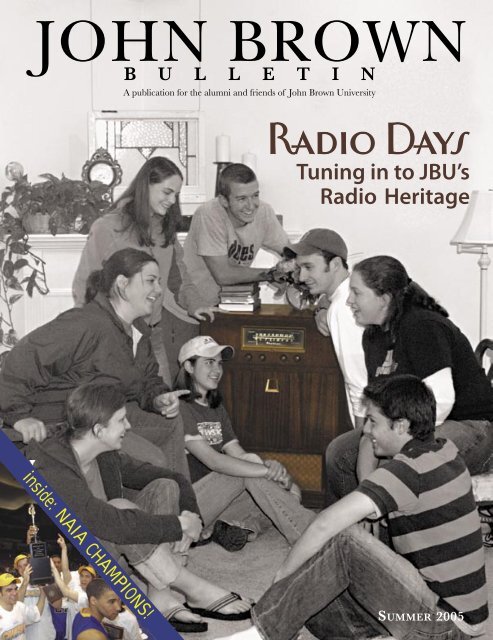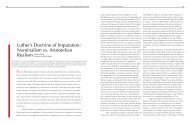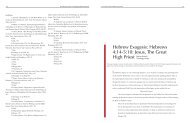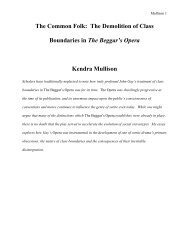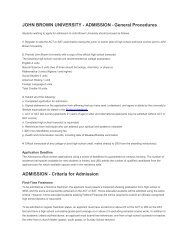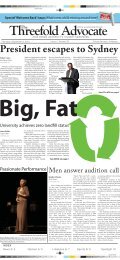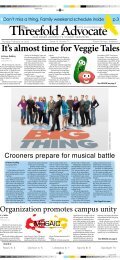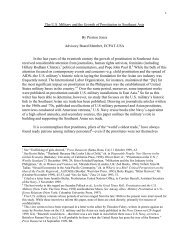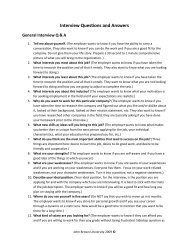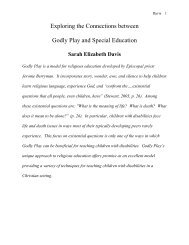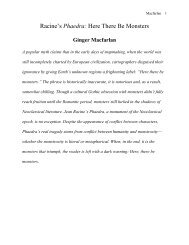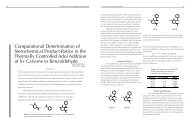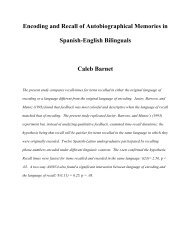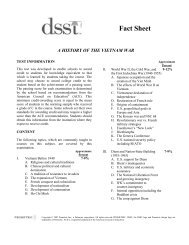Summer 2005 - John Brown University
Summer 2005 - John Brown University
Summer 2005 - John Brown University
- No tags were found...
You also want an ePaper? Increase the reach of your titles
YUMPU automatically turns print PDFs into web optimized ePapers that Google loves.
JOHN BROWNB U L L E T I NA publication for the alumni and friends of <strong>John</strong> <strong>Brown</strong> <strong>University</strong>Radio DaysTuning in to JBU’sRadio Heritageinside: NAIA CHAMPIONS!SUMMER <strong>2005</strong>
Letter from the<strong>Summer</strong> <strong>2005</strong>JOHN BROWNB U L L E T I NDear Alumni and Friends of JBU,PresidentGreetings. We are in exam week on campus, and the traditional undergraduatestudents are anxious to finish up and begin their summer. Most will be heading offto summer jobs, but over 160 students will be participating in one of JBU’s internationalmission or study programs in Northern Ireland, Germany, France, Britain,or Mexico. Studies have shown that overseas experiences greatly enhance students’academic and spiritual growth at college, and we are privileged to offer them as partof JBU’s program.EditorAlumni News EditorsContributing WritersLead DesignersDesign AssistanceProduction AssistancePhotographersAndrea PhillipsJean FraseLindsay DikesLeila McNeillAndrea PhillipsTraci CollinsAndrea PhillipsAllen DempseyJennifer TrenchardChristine MescherLuke DavisMark JacksonJennifer TrenchardI am also wrapping up my first year as president, and it has been a full one, as youcan see from the stories in this edition of the Bulletin. We made a difficult decision inselling KUOA, but it was made in light of the great success of KLRC. We dedicateda new residence hall, North Hall, and it is meeting a critical need for residentialspace for our growing undergraduate population. Our men’s basketball team providedthe most welcome surprise of the year by winning the NAIA national championshipas an unseeded team. Congratulations to Coach Sheehy and his team.This year we marked the passing of Mrs. Caroline <strong>Brown</strong>, the second “First Lady”of <strong>John</strong> <strong>Brown</strong> <strong>University</strong>. Carey and I had the privilege of visiting with Carolinethis past December, so we were able to catch a glimpse of her passion, hospitality,and self-sacrificing service to others. Even in a short time, we recognized that shewas a remarkable woman with a deep commitment and love for JBU. She will bemissed.Carey and I have had the pleasure to meet many of you through JBU’s alumnievents. We have enjoyed hearing your stories about Dr. <strong>John</strong> Panage and Dr. DorothyWoodland, the Harmonaires and the Sound Generation, the vocation credit andchapel pranks. You honor us with your stories because through them you invite us tojoin in the history of JBU. We look forward to hearing many more.We appreciate the warm welcome that we have received this past year, and we remaindeeply committed to the mission of <strong>John</strong> <strong>Brown</strong> <strong>University</strong>. Thanks for beingsuch a vital part in helping us in that task.God-speed,PrinterMagna IV PrintingThe <strong>John</strong> <strong>Brown</strong> Bulletin is the official publication of<strong>John</strong> <strong>Brown</strong> <strong>University</strong>. It is published at 2000 West<strong>University</strong> Street, Siloam Springs, Arkansas 72761.To submit story ideas, photos, feedback:Andrea PhillipsDirector of <strong>University</strong> Communicationsaphillips@jbu.eduAlumni news and photos:Jerry RolleneDirector of Alumni and Parent Relationsjrollene@jbu.eduAdmissions information:888-JBU-INFOjbuinfo@jbu.eduwww.jbu.edu/admissionsFor information about giving to JBU:www.jbu.edu/giving or 800-446-2450Dr. Charles W. Pollard
Not an Average College Radio Station 12Golden Eagles win NAIA Championship 16North Hall Ceremony 6features8 Radio Days: Tuning in to JBU’s Radio HeritageJBU’s Radio HeritageTracing JBU’s connections to radio from the founder to nowby Heather Crain ’0311 JBU Sells KUOA12 On Air: KLRC Is Making a Positive DifferenceKLRC is successfully continuing JBU’s work in radioby Angela Slaughter16 Golden Eagles Win NAIA Championshipby Jonathan VerHoeven18 Our Farewell to Caroline <strong>Brown</strong>departments7 Chaplain’s Corner by Tracy Balzer21 Stories from the Road by James Elliott ’9922 Perspectives On...“Doing Good for Those in Need”by Dr. Ed Klotz III ’6823 World View“The Harvest Is Just a Mouse Click Away”by Karen Azucena ’9935 FlashbackLife in the Dorm<strong>John</strong> <strong>Brown</strong> <strong>University</strong> provides Christ-centered education thatprepares people to honor God and serve others by developing theirintellectual, spiritual, and professional lives.C OV E R PHOTO Luke Davis ’05S T U D E N T S PICTURED Laura Burmeister, MelissaEarl, Tracie Faust, Leah Hall, Alyson Janacek, AlexMcEachin, Paul Tharp, Chase Willsey
LettersFlashback FeedbackThe new format of the Bulletin is a great improvement. Better forinitial scan-through, better for photography, better for detailedreading. My compliments.I only have one complaint. It is the prominenceof Bill Clinton in the 1978 flashback on the last page.True, it features his presence as governor of Arkansasat <strong>John</strong> <strong>Brown</strong> III’s inauguration – far before Clinton’sscandal-ridden presidency. However, we now knowthat his personal life, both before and during hispresidency, was immoral and non-Christian. JBUhas a tremendous reputation as one of the nation’s greatest Christcentereduniversities, and thousands of JBU graduates are livingsincere Christian lives and showing Christ to others—particularlyin the secular field. Given that, I feel that featuring Bill Clintonbesmirches JBU’s reputation and is inappropriate.Thanks for listening, and God bless JBU!Eldon Green ’64Vonore, VT[You] should be proud of the quality of your publications. From theHomecoming invitation to the various Bulletin magazines, I must saythat the design and writing come together with excellence. Thanksfor representing the institution so well.That being said, I can’t help but mention what a let-down Iexperienced after having gone over each page in this last issue toreach the final page. Of all the flashback memories to highlight, theselection of Bill Clinton really was a poor choice. I try not to bringany association between a president associated with immoral, selfcenteredbehavior and my alma mater, an institution that has stoodfor biblical values and high standards of excellence since before hewas born. It’s not a partisan concern, but one of an inappropriatedecision.Again, that was one of 48 otherwise great pages. Just thoughtI’d share my first impression.Ken Haron ’80Highlands Ranch, COFrom the EditorThanks to those of you who let us know both your complimentsand your concerns about the last issue of the <strong>Brown</strong> Bulletin. Suchfeedback is invaluable as we pursue a level of quality in ourpublications that reflects the quality and character of JBU.I truly appreciate the perspectives and comments we receivedregarding our choice to include the Bill Clinton picture. We didcarefully consider the pros and cons of including it for the veryreasons mentioned above. Ultimately, we concluded that theprimary purpose of the Flashback page is simply to remind alumniof the life and events of JBU’s past. Most alumni from the late ’70srecall – with either pride or shame – that Bill Clinton did indeedvisit JBU while governor of Arkansas. And those who rememberthe inauguration of <strong>John</strong> <strong>Brown</strong> III most likely also remember thatClinton spoke at the event. We finally decided that not includingthe photo of a former U.S. president who was once invited to andappeared on campus could have been interpreted as a partisanchoice on our part.In producing the <strong>Brown</strong> Bulletin, we’re trying our best to beinteresting, accurate, and fair while being guided by JBU’s Christcenteredmission. Please keep your comments coming so we canlearn how we’re doing with each step.Andrea PhillipsEditor, <strong>John</strong> <strong>Brown</strong> BulletinJBU MailTo Dr. Steve Beers, Vice President for Student Development, and Mr. AndreBroquard, Director of Residence LifeAlmost 20 members of the ultimate frisbee team attended theMardi Gras Ultimate Frisbee Tournamentin Baton Rouge, Louisiana this weekend.My family and I were privileged and blessedto host the group, which included our son.The purpose of this note is to bragon these young men and women. Theyspent two nights at our house and weattended several of their games. They wereappreciative of even the smallest things weprovided and let us know it. They respectedour property and our sanity. They were apleasure to have and were truly very little trouble.On and around the playing field, the team continued to clearlydemonstrate Christ-like behavior. The witness of this group’sparticipation extends well beyond the playing field. Friends andcoworkers who know of this visit are surprised when I tell themabout this group...They recognize that there is something differentabout this group, and that opens doors to explain that difference.Finally, I must tell you that I learned from them. I learnedto trust God when my son says, “I’m bringing 20 friends home.Don’t worry, Dad. We can sleep on the floor or wherever. It’llbe fine.” I was humbled and inspired by the walk with God Isaw among the members of the team. We are thankful for theopportunity to spend time with the Ultimate Frisbee team, andwe received blessings through them. God is doing a great workthrough <strong>John</strong> <strong>Brown</strong> <strong>University</strong> and its outreach through clubslike this.Jak StallingsPrairieville, LALetters are published with the permission of the author. Some letters have beenedited for length. Not all letters can or will be published. Published letters willbe selected based on the value of their content, tone, clarity, and other similarcharacteristics. Send your letters by e-mail to Andrea Phillips at aphillips@jbu.edu or by U.S. mail to: Andrea Phillips, <strong>Brown</strong> Bulletin Editor, <strong>John</strong> <strong>Brown</strong><strong>University</strong>, 2000 West <strong>University</strong> Street, Siloam Springs, AR 72761.4 <strong>John</strong> <strong>Brown</strong> Bulletin <strong>Summer</strong> <strong>2005</strong>
jbu in focusClassroom MeetsRoman Culture FirsthandTwo JBU professors and six students traveled toRome, Italy over spring break. The trip was offered tostudents taking Roman Empire and Renaissance EuropeanHistory classes.“The best thing about going to a city like Rome is beingable to have the textbook right in front of you,” ScottJones, Assistant Professor ofPolitical Science, said.Sophomore Amy vanEttingerwas quoted in JBUʼsThreefold Advocate as saying,“I feel like Iʼve beenreading commentary aboutRome my whole life, andnow Iʼm going to have a conversationwith it.”Amy vanEttinger at the Temple of VestaStudents Aid Professor inOverseas TeachingDr. Dan Lambert, Associate Professor of YouthMinistries, will teach a class on youth culture at KievTheological Seminary (KTS) in Ukraine for two weeksin September <strong>2005</strong>. Last semester, scholarships weresecured for two students to accompany Lambert in thisunique cross-cultural ministryopportunity; Aaron Elmore,a senior youth ministry majorfrom North Carolina, andRyan Hawk, a senior youthministry major from Coloradowill assist Lambert.“Itʼs like the ultimate collegefinal,” said Hawk. “Iʼmlooking forward to this tripbecause it requires me to takeeverything God has taughtme thus far in college and inlife and translate it to have animpact on Russian youth culture.”Dr. Lambert teaching at JBUJBU Wins Federal TRIO Grantto Aid StudentsJBU received a Student Support Services grant of$220,000 a year for five years from the U.S. Departmentof Education. One of the federal programs known collectivelyas “TRIO programs,” Student Support Services(SSS) focuses on low-income students, first-generationcollege students, and students with disabilities. Only thetop ten percent of applicants receive the grant for fiveyears.The grant will provide SSS students with personal mentoringand advising, tutors, financial aid, career counseling,and a special orientation to campus their freshman year.“This program will take what we already did well andallow us to expand it to ensure the academic success ofmore students,” said Cheryl Kester ʼ91, Director of Grantsand Foundation Relations at JBU and author of the federalgrant proposal. “<strong>John</strong> <strong>Brown</strong> <strong>University</strong> already has goodgraduation rates, but we want to make sure that we continueour commitment to making a private education affordableand successful for as many students as possible.”The program will serve 160 JBU students, about ten percentof the student body.SIFE Secures Regional TitleJBUʼs Students in Free Enterprise (SIFE) team wontheir regional competition against six other teams in Memphis,Tenn. on Friday, April15. This is the third time inthree years that JBU hasadvanced to nationals. Lastyear, the JBU SIFE teamtied for fifth in the nation.The JBU team advancedto the finals in two of thefour competition categories:Free Market Economicsand Business Ethics.The team will travel to Kansas City for the national competition,May 23-24. (To learn about the competition results,visit www.jbu.edu/news at the end of May.)SIFE was also recognized on campus as JBU Club of theYear for the second year in a row.Students Collect “Buckets of Love”JBU students launched a “Buckets of Love” TM reliefeffort in March to collect and assemble more than 100buckets that will aid tsunami victims. Local merchants andbusinesses banded together and donated many of the supplies.“Buckets of Love” are packagesof much-needed supplies and toysassembled in sturdy twelve-quartplastic buckets. According to LarsDunberg, president of Global Action,a non-profit organization that issponsoring the nationwide campaign,each item in a “Bucket of Love” waschosen for its usefulness to familiesliving in debilitating poverty. In additionto meeting immediate needs,the gifts in a “Bucket of Love” showhurting people that somebody cares.Global Action provided 100 buckets, and JBU students<strong>John</strong> <strong>Brown</strong> Bulletin <strong>Summer</strong> <strong>2005</strong> 5
jbu in focusand community members collected the supplies to fill them.During a chapel service on March 29, JBU celebrated thecommunity relief effort as Global Action staff collected thefilled buckets.JBU Drops Diving and Men’s SwimmingAfter much consideration, the athletics department,along with JBU officials, has decided to dissolve the divingprogram, along with the menʼs swimming program, effectivewith the <strong>2005</strong>-2006 season. The decision comes aftera steady decline in participation in these programs at JBUand in the NAIA organization, which gives NAIA swimmingan “at risk” status. The JBU womenʼs swimming programwill remain for the <strong>2005</strong>-2006 season.“JBU has a long tradition of intercollegiate swimmingand has had a number of NAIA All-Americans inthe last four decades,” Dr. Bob Burns, Athletic Directorsaid. “The sport served JBU well, but with the declininginterest, it was my recommendation to the presidentʼscabinet that the programs be evaluated and appropriateadjustments made.”“It would be irresponsible on our part to recruit studentsfor the menʼs swimming program knowing thatparticipation is down and the future of swimming programsin the NAIA is uncertain,” said Dr. Ed Ericson,Vice President for Academic Affairs, including athletics.“It is a difficult decision and one that was made withcareful thought and consideration.” ■For more information about these and other news stories, visit www.jbu.edu/newsCrowd CutsNorth Hall RibbonTo celebrate the gift of North Hall,JBUʼs newest residence hall, studentsled a dedication ceremony on Friday,April 1. Rain chased the festivitiesindoors to Sells Gymnasium, wherestudents, faculty, staff, members of theboard of trustees, and a number of JBUfriends heard testimonies from NorthHall residents about their experiences inthe new building. (North Hall openedto residents in August 2004.)“As I think about the blessing thatmy home in North Hall has been thisyear and look forward to the future,my vision for North Hall is that it willbe a place where we see [Christ] moreclearly and learn to walk with Himmore intimately each day,” said NorthHall resident Rebekah Frazier duringthe ceremony.In the tradition of CaliforniaDorm, a framed photo of NorthHall residents was presented tothe university to be hung in thehall lobby.A break in the rain allowedthe ceremony to conclude outside,across the road at NorthHall. There, all the studentsin attendance, together withboard of trustee members andother special guests, wereinvited to cut the five-foot wide, redribbon stretched across the front of thebuilding.A lead gift from an anonymousdonor, along with generousgifts from the ChapmanTrusts of Tulsa, the J. E. and L.E. Mabee Foundation of Tulsa,and the Sunderland Foundationof Kansas City, made NorthHall possible. ■6 <strong>John</strong> <strong>Brown</strong> Bulletin <strong>Summer</strong> <strong>2005</strong>
chaplain’s cornerWhy Does God Hate Africa?And other honestquestions…by Tracy BalzerDirector of Christian FormationMy student friend, Kristen, produced a virtual Niagaraof tears as she sat on the big purple couch in my office,telling me of her experience watching the movie “HotelRwanda.” Reflecting on the reality of poverty, slavery,civil war, hunger, and AIDS, the honest cry of her brokenheart was, “Why does God hate Africa???”Kristen knows, of course, that God certainly doesnot hate Africa, that He is not inflicting some greatpronouncement of punishment on them, that He hasnot turned His back on this suffering continent. Shewas merely speaking from a heart that is heavy withthe suffering of the world. And broken hearts bring honestquestions.But the broken hearts of our students also produce a greatpassion to join the redemptive work of God, and it is one of thegreatest joys of my life to see our students move from pain, toquestioning, to prayer, to action. Just this semester we’ve seenstudent-initiated efforts to help relieve the suffering of tsunamivictims. About 100 “Buckets of Love” were assembled by campusand Siloam Springs community members and then commissionedin a special chapel service. Twelve of our students gave up theirspring breaks to become immersed in the needs of refugees in theU.S., while another group of seven worked on houses in Floridawith Habitat for Humanity. And Kristen and her friends directed acampus-wide AIDS campaign to alert us to the growing numberof orphaned children in Africa, which will result in a new “Actingon AIDS” campus ministry.Questions, pain, tears…redemption. It’s a process we see overand over here on campus. Kristen and her fellow students arelearning that they are God’s instruments of healing in a desperateworld, a world that God “so loves.” This is a lessonwe can all learn; that if we’re brave enough toask the honest questions, we may find that Godwants to use us to bring redemptive answers. ■<strong>John</strong> <strong>Brown</strong> Bulletin <strong>Summer</strong> <strong>2005</strong> 7
Radio DaysTuning in to JBU’s Radio HeritageBy Heather Crain ’03Archives CoordinatorWhen <strong>John</strong> E. <strong>Brown</strong> Sr. foundedJBU in 1919, he did notabandon his call for evangelism,but instead embraced both hiseducational dream and hiscalling by combining themwithin the operations ofJBU. The school’s associatedradio stations – JBU hasowned about ten stationsto date – were integral tothe founder’s blending ofevangelism and education.All of JBU’s radio stationswere dedicated, in thefounder’s words, to broadcastingmessages “oninterdenominationalevangelism, three-foldeducation, and aboveeverything else, the buildingof the American Homeand the training of ourAmerican youth.”8 <strong>John</strong> <strong>Brown</strong> Bulletin <strong>Summer</strong> <strong>2005</strong>
Through the lens of <strong>John</strong><strong>Brown</strong> Sr.’s threefold approachto life – Head, Heart, Hand– we can see that JBU wouldnot be the institution that it istoday without the integrationof radio broadcasting into thehistory and development ofthe university.HeadEarly in the history of radiodevelopment, <strong>John</strong> <strong>Brown</strong>Sr. recognized the potentialthat existed in associating hismission and his schools withradio broadcasting. He oncewrote, “from the inception ofthe <strong>John</strong> <strong>Brown</strong> Schools, radiohas played a large part in ourwork.” JBU’s first station beganin 1928 when Brother <strong>Brown</strong>broadcast Gospel messagesfrom campus over the 50-watt station KFPW. Thecall letters stood for “Kind Friends Please Write,” butsince the friends within the fifteen-mile broadcastingradius didn’t write, the station was sold a year later.<strong>John</strong> <strong>Brown</strong> Sr. did not give up; he knew that radiowould provide the best publicity for his fledglingschool. After his experiment with KFPW, <strong>Brown</strong>obtained KUOA from the Fulbright interests inFayetteville, Arkansas. Purchased for $16,000 in 1935,<strong>Brown</strong> stated that after several years of successfuloperation, KUOA “is worth a quarter of a milliondollars to me in advertising for our university.” <strong>Brown</strong>used the commercial station to share his evangelisticmessage and to help raise funds for the growinguniversity in Siloam Springs.With the addition of KUOA-FM in 1947, JBU ownedthe first FM station in Arkansas. Since KUOA (AM)was a daytime station, its broadcasting day endedat sundown, but KUOA-FM broadcasted until 10:15p.m. each night, providing radio programming forpeople throughout Arkansas, Oklahoma, Missouri,and Kansas.Off campus, JBU operated a number of stationsaround the country, including: KMCK of Fayetteville;KGER, in Long Beach, California; KOME of Tulsa,Oklahoma; KGOL of Houston, Texas; KBBW of Waco,Texas; and WJST and WJBU AM and FM in PanamaCity, Florida.Commercial stations such as KOME in Tulsa andKGER in Long Beach were set up so that their profitscontributed to the university’s endowment. Financialstability and building the endowment were majorgoals for JBU, and it was a requirement for continuingA well known portrait of <strong>John</strong> <strong>Brown</strong> Sr. shows him with hisBible and a KUOA microphoneacademic accreditation.In an article writtenfor the January 1952 JBUBulletin, Storm Whaley ’35,executive vice presidentof the university anddirector of the JBU radiostations, wrote of the radiostations’ goals, saying, “the<strong>Brown</strong> Stations serve theirlisteners with wholesomeconstructive radio programming”and supply“income to <strong>John</strong> <strong>Brown</strong><strong>University</strong> through thecommercial operationof the stations.” Whaleyadded that the stationsprovided “a means forincreasing the enrollmentsof all the schools—andfor giving the story of ourstudent loan fund and itsneeds to people who are looking for a place to puttheir money into the lives of young people.”One benefactor, the late Murray C. Sells,heard of JBU in this manner. Sells, a Muskogee,Oklahoma banker who went into the oil businessin Gladewater, Texas, was on his oilfield at fiveo’clock in the morning waiting for a well to comein when he heard the voice of <strong>John</strong> E. <strong>Brown</strong> Sr.over his radio. <strong>Brown</strong>’s philosophy of threefoldeducation made such a strong impression on Sellsthat he wrote <strong>Brown</strong> and formed a friendship withthe university that lasted twenty years until hisdeath in 1953.Sells made large donations to JBU several times,and upon his death, Sells left 20 percent of hisremaining estate to JBU. This money increasedthe university’s endowment, bringing JBU withinreach of qualifying for accreditation by the NorthCentral Association of Colleges and SecondarySchools.HeartBeginning in 1928 with KFPW, <strong>John</strong> <strong>Brown</strong>Sr. saw the tremendous opportunity in radiofor reaching the masses with the message ofevangelicalism. Between 1929 and 1935, when JBUdid not own a radio station, <strong>Brown</strong> still sent hismessages over the airwaves by purchasing time onsome of the leading radio stations in the countryfor his program, “God’s Half Hour.”<strong>Brown</strong> produced radio programs for close tothree decades, and he was dedicated to sharing hisradio messages up until his death in 1957. The late<strong>John</strong> <strong>Brown</strong> Bulletin <strong>Summer</strong> <strong>2005</strong> 9
Cecil Smith ’41 once recalled that while he and hiswife were living in California in 1934, <strong>Brown</strong> wouldget up at 4:30 a.m. and come to their apartment torecord his sermons onto transcription disks to besent to KGER and KUOA for their programming.While JBU’s stations were not always locatednear the university, the stations were still held tothe same standards of moral living and Christianideals as existed at the campus. The slogan for theJBU-owned stations, “The Stations of the AmericanHome,” demonstrated these ideals. The stationswere dedicated to maintaining quality programmingwith “the very best of education, religion, news,music, amusements, and recreation.” As long as astation was owned by JBU, it aired programmingthat reaffirmed and supported Christian values.The pragmatic manifestations of this policyappeared in the stations’ sales and advertisingdepartments. Although most of the stations werecommercially operated, <strong>Brown</strong> refused to aircommercials that were thought to undermineAmerican ideals or contribute to the bad habits ofAmerican youth, which included advertising foralcohol and cigarettes.When JBU purchased KOME in Tulsa in 1951,this commercial policy went into effect. It caused astir in the community when KOME, which relayedprogramming from a Mutual Broadcasting Systemaffiliate station, refused in advance to air ads froma beer sponsor during the upcoming major-leaguebaseball broadcasts. KOME withdrew from theMutual affiliate when the other station would notaccept KOME’s policy, becoming the first majornetwork affiliate to drop its affiliation rather thanaccept advertising that it felt would be against itsideals.While this action caused the station’s finances totemporarily dip into the red, KOME was supportedby the Tulsa community and was recognizednationally for its dedication to wholesome ideals.10 <strong>John</strong> <strong>Brown</strong> Bulletin <strong>Summer</strong> <strong>2005</strong>Storm Whaley broadcasting on KUOAOther stations followed KOME’s example, refusingto air commercials for products that they did notsupport, and in 1955 the station rejoined the Mutualnetwork under a new contract that adhered to KOMEadvertising standards.JBU also opened its radio studios to otherevangelistic organizations. Missionary groups suchas the Far Eastern Gospel Crusade (today known asSEND International) were assisted by the use of JBU’sradio studios and staff. When the original challengeto build a gospel broadcasting station in East Asiacame through the FEGC, JBU students and graduatesformed the skeleton crew to build and operate thestation and recorded some of its broadcasts on theJBU campus. From 1948-1950, students also workedwith Japan’s Voice of Christian Radio to produce itsradio program in the KUOA studios.HandBy 1927, JBU students were provided with a radiorepair shop as a choice for vocational duties andtraining, and students helped <strong>John</strong> <strong>Brown</strong> Sr. starthis radio evangelism over KFPW. Since 1935, whenJBU purchased KUOA, the university has been trainingstudents in broadcast engineering by providingthem with hands-on experience in student-operatedstations. Both KUOA and KUOA-FM employedminimal staff and made student interns an integralpart of the stations’ operations. Don Smith ‘48 remembersthat as a freshman in 1945, Storm Whaleyneeded him to study for his operator license for runningthe transmitter because the only other studentwith a license wasgraduating at theend of the semester.The universitycampus has offeredseveral othertraining opportunitiesto itsstudents. In 1948,JBU started a carrier-currentstationcalled KJBU,which broadcastedfrom thecurrent HydeBuilding at 600on the AM dialto radios pluggedinto the electricaloutlets ofthe dorms. Thestation held thecampus as its au-Bill Fairley and Les Wright in the 1930s
JBU Sells KUOASOLD<strong>John</strong> <strong>Brown</strong> Sr. in 1949dience, and it provided the studentswith another occasion forlearning the ropes of broadcasting.In 1970 KJBU was revived whenstudents replaced the transmissionlines and joined the IntercollegiateBroadcasting System.According to Arnie Mayer ‘66,JBU associate professor of broadcasting,KJBU “was a complicatedmethod of transmission to threedorms on campus. Each dorm hadits own transmitter that broadcastthe signal through the 110v powerlines. There were times whentransmissions interfered with eachother and created an annoyingwhistle effect in the audio. Thesystem was old, problematic, andneeded replacement.” In 1995, anew “through the air” low-powerstation, KARQ or Q16, replacedKJBU and broadcast at 1600 on theAM dial. At 10 watts, the station’sprogramming is available to theentire extended campus and thesurrounding nearby residential areas.The station is only on the airwhen students are enrolled in BeginningRadio Practicum, whichgives the students experience inpicking music and designing radioprograms.KLRC, named after the Learningcontinued on page 20After extensive consideration, JBUagreed to sell KUOA to CherokeeBroadcasting, Co., owned by Deweyand Mitchell <strong>John</strong>son. JBU andCherokee Broadcasting signed an assetpurchase agreement and time brokerageagreement on December 21, 2004, andthe transaction was completed at the endof March <strong>2005</strong>.“It was a difficult decision for theboard of trustees because KUOA hasbeen an important part of the historyand support of JBU,” Dr. CharlesW. Pollard, <strong>University</strong> President said.“However, after weighing the pros andcons carefully, the trustees accepted therecommendation of the administrationand were unanimous in their decisionthat selling the station was in the bestinterest of the university.”JBU purchased KUOA in 1935.<strong>University</strong> founder <strong>John</strong> <strong>Brown</strong> Sr. usedthe station to expand his radio ministryand to provide broadcasting training tostudents at the university, which it diduntil the early 1970s. But JBU studentshave not been significantly involved inKUOA operations for about 30 years. Inthose decades, the station was operatedprimarily as an endowment asset of theuniversity rather than as part of JBU’seducational program. In recent years,the station did not provide an investmentreturn for the endowment. In the courseof reallocating endowment assets intoinvestments with higher potential forgrowth, the board of trustees reviewedthe status of KUOA. The decision tosell the station was in keeping with theirreallocation strategy.JBU has continued its strong broadcastingprogram through KLRC, itsDove Award-winning, contemporaryChristian radio station, which was startedin 1983. Students working at KLRCparticipate in live remote broadcasts,promotions planning, concert coordination,production, and new programcreation.“We have enjoyed great successwith KLRC,” said Sean Sawatzky ’96,KLRC station manager and formerKUOA station manager. “KLRC isa non-commercial station, which isbetter suited to our educational and ourprogramming goals.”KLRC is financially self-sustainingthrough contributions of its listeners.Support for the popular FM stationis demonstrated each year duringSharathon when KLRC solicits andreceives pledges to satisfy its operatingbudget.“In many ways, KLRC fulfills JBU’smission today in the same way as KUOAserved the university 30 or 40 yearsago,” Pollard said. “It trains students; itpromotes the gospel; and it is financiallyhealthy. Through KLRC and our finebroadcasting department, JBU remainscommitted to educating students whowill shape the broadcasting industry forGod’s glory.” ■<strong>John</strong> <strong>Brown</strong> Bulletin <strong>Summer</strong> <strong>2005</strong> 11
By Angela SlaughterKLRCis makinga positive differencein Northwest Arkansasand at JBU.It’s not justyour average collegeradio station.12 <strong>John</strong> <strong>Brown</strong> Bulletin <strong>Summer</strong> <strong>2005</strong>
Melody Miller ’00KLRC Program DirectorWhen KLRC was born in thesummer of 1983 as a trainingground for JBU broadcasting students,perhaps no one, even the station’sinitiator, former communications professorMike Flynn ’58, could have envisionedwhat KLRC would become.Twenty-two years have passed sinceProfessor Flynn’s vision was realized,and while the station continues toprovide quality, hands-on experienceand training to JBU students, theKLRC of today far exceeds its foundingpurpose. These days, KLRC extends itsservices and caring reach not only toJBU students, but also to thousands ofpeople in Northwest Arkansas.Without a doubt, the ministryof KLRC is changing lives with itsdedication and commitment to “makea positive difference...for Christ,” allthe while, retaining its status as one ofthe top Christian radio stations in thecountry.So what makes KLRC so unique?How is it that a college radio stationwith such humble beginnings is ableto so intensely make its mark? Perhapsone reason is that KLRC has remainedtrue to the objective for which it wascreated—to serve JBU students.Melody Miller assumed the position ofKLRC Program Director after her graduationfrom JBU. In addition to her responsibilitiesfor the day-to-day operation ofKLRC, Melody hosts the station’s morningshow, airing weekdays from 6:00 a.m. –9:00 a.m. When asked what aspect she loves most about her job,Melody says, “The short answer would be, I get to be aroundmusic that I love and music that changes people’s lives on a dailybasis. I get to play a small part in what God is doing in the livesof thousands of people in Northwest Arkansas—through a song,through a promo, through something I say on air. I get to workwith students, teaching them what I know, encouraging themto find their passion and calling, coaching them to be the bestthat they can be, and then sharing in the process of watchingthem grow both on-air and off-air.” Melody continues, “But Ithink for me the most exciting moments are when you know forcertain that you are right in the middle of something that God isdoing.”“Student involvement is an integralpart of who we are,” KLRC generalmanager Sean Sawatzky ’96 stated.“As the station becomes more andmore popular, our commitment to thiselement only grows.” JBU studentsparticipate in station activities such ason-air announcing, promotional efforts,event planning, and general officeduties.Former KLRC student announcerand JBU Walton Scholar VivianEchegoyen ’94 recalled her experienceat the station, saying, “I had the timeof my life working at KLRC. I lovedgetting behind the microphone andknowing that through what I was doing,the Lord was using me to bless manylisteners.”KLRC continues to shape andinspire current JBU students. Servingas a student announcer at KLRC, JBUjunior Daniel Silver said, “KLRC hashad an amazing impact on my life.Being able to be on the radio and try tohelp lift others up in Christ is somethingI will treasure forever.”Regarding student involvement,Sawatzky added, “When a student putsKLRC on their resume, they’re tellingan employer that they’ve worked at anational award-winning radio station,and they graduate with a tremendousamount of real-world experience.”In fact, KLRC is the only studentoperatedradio station in the countryto win Dove Awards from the GospelMusic Association (GMA). In 2001 and2002, KLRC accepted the outstandingChristian artists regularly take part in KLRC broadcasts and programs. Artists pictured above,left to right: two members of the group Alathea, Shaun Groves, George Rowe, Taylor Sorensen,Ginny Owens, Michael Olson.<strong>John</strong> <strong>Brown</strong> Bulletin <strong>Summer</strong> <strong>2005</strong> 13
Mike Kankelfritz ’94Radio Personality,KXOJ-TulsaWhile in high school, a relativetold Mike Kankelfritz, “You havea nice voice. Maybe you shouldthink of radio as a career.” Mikesoon began working in radioat his high school in Seattle,Washington. Shortly after highschool graduation, Mike decidedto attend college to further hisradio training, and Seattle’s losswas JBU’s gain.While attending JBU, Mikeworked at KLRC as a studentannouncer. His duties at KLRCincluded on-air broadcasting andcreating concert promotions.Mike has now been sendinghis voice over radio airwavesfor more than fifteen years,working at stations in Seattle;Fayetteville, Arkansas; GrandRapids, Michigan; and currentlyin Tulsa, Oklahoma. KXOJ100.9 in Tulsa is a well-knowncontemporary Christian stationand three-time GMA awardwinner. At KXOJ, Mike hosts themorning show from 6:00 a.m.– 10:00 a.m. and is a popularstation personality.Regarding his experience atKLRC, Mike says, “KLRC wasa great laboratory. At KLRC,you had the freedom to makemistakes, yet at the same time,you had to be professional…Some schools just have the‘campus radio station.’ KLRCwas and is much more thanthat.”KLRC’s “Coats for Kids” drive allowed listenersto contribute winter coats to benefit the needythrough Salvation Army locations in NorthwestArkansas. The first drive in 2004 wasso successful that KLRC plans to make it anannual event.and coveted honor of the GMA MusicAward (the Dove Award) for SmallMarket Radio Station of the Yearand was one of three finalists for thesame award in 2004. Additionally,KLRC continually receives nationalrecognition from other radio stationsand record labels in the industry. Allthings considered, JBU broadcastingstudents could not ask for a better placeto get started in the field.Today’s KLRC, however, doesnot stop with the goal of studentinstruction. “We are able to still provideexcellent [student] training whileattracting a weekly audience of almost40,000 people,” Sawatzky noted. Thestation’s staff is united in its purpose toprovide “a real service to the people ofNorthwest Arkansas.”Certainly, KLRC provides encouragingChristian music, but it is alsoinvolved in community outreach effortsthat include Operation ChristmasChild, Clergy Appreciation Month,Northwest Arkansas’ Biggest BabyShower, and Military Moms’ Day atthe Mall, just to name a few. Sawatzkyobserved, “It seems the more we focuson [serving the people] and the less wefocus on trying to achieve certain standardsof success...the more successfulKLRC actually becomes.”KLRC staff members prize theirconnection with the people who listen,and KLRC listeners are enormouslydedicated to supporting the station.As a listener-supported radio station,KLRC depends on financial donationsto fund its annual operating budget.This March, KLRC’s annual Sharathonbrought in about $370,000, surpassingthis year’s goal of $365,000 andradically exceeding the original 1996Sharathon total of $33,000. One onaircaller recently stated, “I am inspiredby the music and all you do, and weare praying for KLRC.” As KLRCreaches out to the people of NorthwestJBU students and KLRC announcers serve as hosts and waitstaff at KLRC’s Clergy AppreciationBanquet, a free event for area pastors. Approximately 200 attended the <strong>2005</strong> banquet.14 <strong>John</strong> <strong>Brown</strong> Bulletin <strong>Summer</strong> <strong>2005</strong>
A television newscrew interviewsKLRC staff andcontestants at lastyear’s spa giveawaypromotion.KLRC listenerseach placed ahand on the spa,and the last onestanding withoutremoving his orher hand wonthe spa.Arkansas, the people, in turn, continueto respond with appreciation for theservices the station provides.While the station is indeed proud ofits beginnings, the ministry of KLRChas flourished to become something noone could have foreseen at its inception.“[KLRC is] hardly the same station itwas twenty years ago,” Sawatzky stated.“In the early days, KLRC was yourtypical college radio station. Everybodyplayed the music they wanted to play; itwas off-air frequently; and there wereno listeners to speak of. I rememberthat KLRC went dark every nightaround 10:00 p.m., even until 1994 or1995. Obviously, listener response wasnot nearly as strong then as it is now—itVolunteers take pledgesduring KLRC’s annualSharathon. The two-dayfundraising event is precededby a day of prayerand praise, during whichlisteners are invited to callthe station with their testimoniesand praises. In<strong>2005</strong>, Sharathon broughtin about $370,000 forKLRC’s operating budget.1400 listeners contributed;about 600 of thosewere new gifts, while 800were renewal pledges.was truly just a college radio station.”These days, JBU and KLRC embracethe opportunity to truly affect lives witha ministry that God has blessed beyondanyone’s expectations. In the wordsof Sawatzky, “I love that we are partof something bigger than any of us. Ilove that God is using this 6,000-watt,student-staffed radio station to changelives in Northwest Arkansas. I lovehearing the countless testimonies ofhow God uses KLRC. I love that whileI hope to use my position at KLRC tobless others, I am often blessed myself.Even if I didn’t work at KLRC, I wouldbe blessed by the radio ministry itprovides.” ■Liz Smith ’05KLRC Student AnnouncerLiz Smith, a digital mediamajor/broadcasting minor fromColorado Springs, Colorado,served on the spring <strong>2005</strong> studentannouncing staff at KLRC. Shehas been an on-air announceron Monday mornings andWednesday afternoons. Liz hasenjoyed her time at KLRC, butadmits, in the beginning, shewas quite apprehensive aboutthe prospect of being “on-air.”Liz said, “Radio is not my strongpoint, and I was rather nervous.However, my Monday andWednesday shifts have becomesomewhat of a highlight of thissemester. I have come to viewthose four hours a week as timeset aside from doing anythingelse, and it has almost becomea ‘quiet time.’ I find it upliftingand edifying.” When asked whathas made her experience atKLRC so rewarding, Liz answers,“The people that work at KLRChave been so gracious andencouraging to me. They trulywant the best for the listenersand are constantly positive....Itis rare to find a place that holdssuch views and values in today’swork environment.”<strong>John</strong> <strong>Brown</strong> Bulletin <strong>Summer</strong> <strong>2005</strong> 15
Golden Eagles NAIAThe J BU Golden Eaglessoared past Azusa Pacific,65-55, to capture the NAIADivision I National Championshiptitle in Kansas Cityon March 22.The team’s progressive successthrough the tournament, culminatingin the ultimate victory, sparked aflurry of community attention, campuscelebrations, and media coverage thatlasted for more than a week.The Cinderella story that JBU enjoyedwas more exciting than just onesingle championship game could havetold. It really began on March 18, whenthe NAIA gave Coach <strong>John</strong> Sheehy andhis team an at-large bid to the men’stournament as an unseeded team.Their season had been disappointing.In mid-February the Golden Eaglessat near the bottom of the SAC,but a picture-perfect five-game winningstreak to finish the season tied JBU forthird in the SAC. The Eagles were goingto Kansas City.Round 1: JBU vs. #7 Union— JBUfaced Union (Tenn.), champions of theTranSouth Conference, and closed thefirst half with a 41-25 lead. <strong>John</strong> <strong>Brown</strong>continued to stun Union in the secondhalf, and although Union attempted afurious comeback, the Golden Eaglesconquered Union 84-72.Round 2: JBU vs. #10 LSU-Shreveport—Thetournament’s second roundhad been the demise of JBU in the twoprevious years. This year round twowould be different. LSUS maintaineda lead throughout the first half, but thesecond half was another story. SophomoreAdam Workman hit a threepointerwith 30 seconds remaining inthe game to give JBU a 59-56 lead thatthey stretched to 61-56 at the buzzer.Round 3: JBU vs. Biola—The GoldenEagles took an early lead, but theygrittily clawed their way through thesecond half, relinquishing that lead.Free throws by Alex Terry and BrandonCole gave JBU a 57-54 lead, butBiola scored again to cut the deficit toone. At the free-throw line again, Colescored his 18th point. Biola’s attemptat the buzzer graciously missed the net,leaving JBU ahead58-56.Semi Finals: JBUvs. Carroll College—JBU played frombehind most of thefirst half. The GoldenEagles entered thesecond half trailing32-29, but then theyshut down Carroll’soffense. A BrandonCole three-pointergave JBU a 47-45lead. They continuedto stretch that leaduntil senior reserveand fan favorite TySawyer nailed athree-pointer for thefinal 73-60 margin.That night, manyNorthwest Arkansanssaw their firstglimpses of the GoldenEagles when gamehighlights were playedon the 10:00 sportscasts.Tape of BrandonCole draining twotreys in the faces ofdefenders, ReyjavickDe Gracia doing a chin-up on the rimafter slamming a breakaway dunk, andAdam Workman hitting his buzzerthree proved that these men in blue andgold were skilled athletes, even if theyweren’t the Arkansas Razorbacks.The media coverage acceleratedTuesday as <strong>John</strong> <strong>Brown</strong> fans mobilized.<strong>University</strong> staff and faculty chartered abus to take them to Kansas City. Additionally,large numbers of neutral spectatorsended up siding with the GoldenEagles. Several players commentedlater that playing in Kansas City waslike playing at home.The Finals: JBU vs. #9 Azusa Pacific—Whenthe championship gametipped off, 4,803 people were in thestands of Municipal Auditorium, a majorityof them supporting the GoldenEagles. On the Siloam Springs campus,an additional 120 fans were gatheredin the Walker Student Center towatch CSTV’s national coverage.The first few minutes were tense asthe Cougars took a 4-0 lead, but theGolden Eagles surged back, taking a31-23 lead into halftime. The GoldenEagles scored the first six points of thesecond half, but with about ten minutesremaining, Azusa launched a 13-0 run,to pull ahead. Then JBU regained ashaky lead which they solidified in thefinal two minutes, winning 65-55.16 <strong>John</strong> <strong>Brown</strong> Bulletin <strong>Summer</strong> <strong>2005</strong>
National ChampsBy Jonathan VerHoevenJBU radio announcer Phillip Moreshead’05 described the final seconds,screaming so loudly that his deep voicecracked repeatedly. Cole threw theball high into the air with both handsstretched skyward and was immediatelyembraced by Pat Smits. Soon, the entirebench joined them, jumping andshouting. Only De Gracia was absent.The Panama native was face down onhis knees at center-court, too overcomewith emotion to move.Fans in Kansas City and SiloamSprings celebrated raucously. Theirteam had become the first team fromArkansas and the third unseeded teamin NAIA history to win the tournament.Brandon Cole finished the night with 25points, earning him the tournament’sMVP award. Smits joined Cole in beingnamed on the All-Tournament team.The Days After—The Golden Eaglesreceived a warm welcome as theyreturned to campus the following day.Because it was spring break, the crowdwas relatively thin. But the returningteam received a police escort throughtown, and television and newspaper reportersstayed around for more than anhour interviewing the champions.A bigger celebration was plannedfor the next week when vacationingJBU students returned. The team enteredthe gym that day to an extendedstanding ovation from more than 400fans.Former JBU presidents <strong>John</strong> <strong>Brown</strong>Jr., <strong>John</strong> <strong>Brown</strong> III, and Lee Balzerjoined current President Charles Pollardin congratulating the team beforethe crowd of students, faculty, staff,community friends, and media representatives.Siloam Springs MayorMoose Van Poucke was on hand to declareMarch 30th “JBU Golden EaglesDay.”Coaches <strong>John</strong> Sheehy and DonnieBostwick ’92 shared their appreciationfor the team’s character as well as theirperformance. And the NAIA championshipbanner was raised to hang inMurray Sells Gymnasium that day.Without a doubt, the <strong>John</strong> <strong>Brown</strong><strong>University</strong> men’s basketball programhas soared to new heights. And certainly,the <strong>2005</strong>-2006 season, whichpromises the return of Brandon Cole,Alex Terry, and other seasoned players,will be one to watch. ■You too can watch the gameand celebrate with JBU!Videos of the championship game canbe ordered through the NAIA. And youcan get your own championship T-shirtwhen you send a donation of any size toJBU’s Fund for Student Financial Support(FSFS). For more information aboutthese offers, and to read an extendedplay-by-play of the tournament, visitwww.jbu.edu/giving/champsTo honor MVP Brandon Cole, Buffalo Funds presented a$1,000 scholarship check to JBU in Cole’s name. <strong>John</strong> <strong>Brown</strong> Bulletin <strong>Summer</strong> <strong>2005</strong> 17
Ella Caroline Trahin <strong>Brown</strong> ’47, wife of former President <strong>John</strong> E. <strong>Brown</strong> Jr., diedFriday, January 28, <strong>2005</strong>, at the age of 82. Funeral services were held at the Cathedral ofthe Ozarks with Dr. David Bush officiating.Born July 26, 1922, in Fayetteville, Arkansas, she was the daughter of Jeanand Zinga Stroupe Trahin. A lifetime resident of Siloam Springs, she graduated fromSiloam Springs High School and from JBU, receiving a B.A. in English. She married<strong>John</strong> E. <strong>Brown</strong> Jr. on November 23, 1941. From 1948 to 1979 she served the JBU familyfaithfully and well as the president’s wife. Mrs. <strong>Brown</strong> earned an associate degree innursing from the <strong>University</strong> of Arkansas in 1974 and later completed the requirementsfor a license in social work. She became Director of Patient Services at Siloam SpringsMemorial Hospital and retired (the second time) in 2000 following 26 years of service.Mrs. <strong>Brown</strong> was a charter member of the Hospital Auxiliary and served aterm as president. She was a charter member of the Siloam Springs Memorial HospitalFoundation Board. She served on the committee and the board that founded the SiloamSprings Adult Development Center. She helped to organize the local chapter of theSalvation Army and served for many years on the board. A faithful member of ChapterT.P.E.O., she served as president 1956-1958 and 1984-1985. She was an active memberof the First United Methodist Church in Siloam Springs.In 2000, Mrs. <strong>Brown</strong> was recognized with a Pioneer Citizen award by theSiloam Springs Chamber of Commerce. She was presented the Dr. Frist HumanitarianAward by Quorum Healthcare in 1986.Survivors include her husband <strong>John</strong> E. <strong>Brown</strong> Jr.; one son, <strong>John</strong> <strong>Brown</strong> III, ofSiloam Springs; four daughters (Karen Wilt ’68 of Siloam Springs; Melinda Pollock ’73of Middletown, Delaware; Julie Miller ’78 of Malibu, California; and Laurie Wilkinson’86of Siloam Springs); fourteen grandchildren; and eleven great-grandchildren.The Caroline <strong>Brown</strong> Endowed Scholarship has been established at JBU inMrs. <strong>Brown</strong>’s honor. If you would like to contribute a memorial gift of any size, pleasecontact Paul Eldridge ’88, Director of Development and Planned Gifts at (479) 524-7468 or (800) 446-2450. ■18 <strong>John</strong> <strong>Brown</strong> Bulletin <strong>Summer</strong> <strong>2005</strong>
The Blessings of Endowed Scholarshipsincluding the Caroline <strong>Brown</strong> Endowed ScholarshipBy <strong>John</strong> <strong>Brown</strong> III and Jim Krall“What I spent I lost; what I possessed is left toothers; what I gave away remains with me.”-Epitaph of a Charitable Man, quoted by Joseph AddisonWe have all been helped to get where we are in life by others–our parents,our family, a teacher, a friend, a key pastor, or mentor. Someoneencouraged us and helped us to grow and reach for our goals in life. Withoutthat help, we would not have been able to attain the position of strength orservice we hold today.The Caroline <strong>Brown</strong> Endowed Scholarship will help many deservingJBU students in future years, just like all endowed scholarships. The annualdollars provided by these endowed funds will help students realize their dreamsby making it financially possible for them to receive a quality Christian educationat <strong>John</strong> <strong>Brown</strong> <strong>University</strong>.Every former JBU student was helped by someone during their dayson campus. In the early years, when students were expected to work as part oftheir payment, <strong>John</strong> E. <strong>Brown</strong> Sr. was still busy raising generous gifts to helppay for a college program beyond what students could afford. Throughout ourhistory, gifts to the annual fund, to the endowment fund, and to the constructionof new buildings have helped lower the costs of room, board, and tuition for ourstudents. Gifts to endowed scholarships at JBU directly benefit students and theirfamilies by offsetting the costs of attendance that must be paid by the student.Endowed scholarships work like this: A gift is given to the university,and the university invests the gift. Each year, the board of trustees designates aportion of the invested endowment fund value for students with financial need.These grant and work scholarships make the difference for many families intheir ability to choose a Christian college for their son or daughter. Studentsof good character and in good academic standing on campus may renew thesescholarships annually until graduation.Endowed scholarships can be funded in one or more of these ways: agift of cash, stock, or other property to an existing endowed scholarship; a gift ofcash, stock, or other property to create a new endowed scholarship; a gift giventhrough one’s will or trust; a deferred gift using a charitable gift annuity, or acharitable remainder trust.Endowed scholarships can be designated in the name of a family,organization, or an individual to be honored in perpetuity. Today, over$10,000,000 exists in endowed scholarship funds at JBU because of goodplanning and Christian stewardship. Besides the Caroline <strong>Brown</strong> EndowedScholarship, over 100 endowed scholarships provide student assistance each year.This year alone, qualifying students received more than $600,000 in financial aidthrough these scholarships.For information on setting up a scholarship, please contact your regionaldirector of development or call Paul Eldridge ’88, Director of Development andPlanned Gifts, at (479) 524-7468 or (800) 446-2450. ■<strong>John</strong> <strong>Brown</strong> III is a former JBU President, the Executive Director of theWindgate Foundation, and a member of the JBU Board of Trustees.Jim Krall is Vice President for <strong>University</strong> Advancement.JBU ENDOWED SCHOLARSHIPS:A Legacy for Future GenerationsJ. L. & Margaret Allhands ScholarshipAmerican Society of Professional EstimatorsPat M. Murphy & W. S. Atherton Pizza Hut ScholarshipAmanda & Bonita Auer Scholarship FundSpencer F. Bartlett Memorial Scholarship FundAnn & Vincent Becker ScholarshipWilliam H. Bell Endowed ScholarshipBella Vista Community Church ScholarshipHeather Benner Memorial ScholarshipWilliam F. & Alice D. Blackburn ScholarshipMarion E. & Roy F. Blackmon ScholarshipDerwood & Kathryn Blackwell ScholarshipBoone-Scholton ScholarshipDavid Scott Brooker Memorial ScholarshipCaroline <strong>Brown</strong> Endowed ScholarshipDonald D. & E. Jeanette <strong>Brown</strong> Endowed ScholarshipJ. Alvin & Mabel <strong>Brown</strong> Memorial Scholarship FundJerome E. & Grace K. <strong>Brown</strong> ScholarshipThe Bryant Family Endowed ScholarshipClaude D. Chambers & George A. Cayce Memorial Scholarship FundHelen M. Clough Endowed ScholarshipRoger F. & Annie Lee Cox Science Memorial ScholarshipCulberson/Netherton Music ScholarshipKenneth Dale ScholarshipDale Davis Memorial ScholarshipSherry Lyn Embrey Memorial ScholarshipEngineering Excellence ScholarshipFamily Studies ScholarshipClinton H. and Jean Anne Fowler Memorial Music ScholarshipFriendship FundCharles & Suszanna Gehron Memorial Scholarship<strong>John</strong> A. Graves ScholarshipGaston Griggs Science ScholarshipFred W. Harper ScholarshipJewell Taylor Littlejohn Harrison Memorial ScholarshipHebrew Evangelization SocietyH. Ezelle Thomas Hensley Endowed Scholarship<strong>John</strong> Poe & Marjorie S. Hensley Memorial Scholarship<strong>John</strong> Herklotz Communication Scholarship FundHerring Missionary ScholarshipH.E.S. Inc. ScholarshipMaude Welch Hess Memorial ScholarshipJim and Marilyn Holliday ScholarshipJames Edwin & Bernice O. Hutton Endowed ScholarshipRobert Jackson Sr. Endowed ScholarshipRalph & Lucy Kennedy Legacy ScholarshipLarry Kreider Endowed ScholarshipJoseph W. & Frances Baker Langley Endowed ScholarshipBobbie Laughlin Math ScholarshipWilliam Douglas Layton Endowed ScholarshipMilton & Leila Levy Endowed ScholarshipStella Lunn Memorial ScholarshipPearl Magnuson Endowed ScholarshipArthur & Martha G. Martin ScholarshipDayton E. McClain Ministerial ScholarshipLloyd McCullough Memorial ScholarshipAlice McQuay Endowed ScholarshipNorma McQueen Memorial Art ScholarshipLarry Meyer Endowed ScholarshipHelen and Mike Milam Endowed ScholarshipJesse L. & Edra V. Miller Endowed ScholarshipMissionary Children’s Scholarship FundMission Endowment for Cross Cultural StudentsMoeller Family Mission ScholarshipJoan B. Naramore Memorial ScholarshipKenneth C. Naramore ScholarshipBill & Beulah Nemeth Scholarship FundNetherton/Culberson Science ScholarshipFred Olney Engineering ScholarshipDorothy F. Osburn Memorial<strong>John</strong> H. Panage English ScholarshipCol. Kenneth W. Patrum Endowed ScholarshipMildred Martin Patterson Endowed Scholarship for Music StudentsMatthew Petelski Memorial ScholarshipTodd Pollan Memorial ScholarshipLydia M. Ramsey Memorial ScholarshipForrest E. & Grace E. Ryder ScholarshipJeff Scholtens Memorial ScholarshipScofield Memorial ScholarshipJudge & Mrs. Dale E. Shannon Endowed ScholarshipFrancene Davis Sharp Health Promotion &Human Performance Scholarship for WomenLetitia M. & Melanie C. Simpson Endowed Scholarship forMinority and Women StudentsRobert L. & Helen Skov Scholarship FundBeverly Meador Sloan Scholarship FundJoe R. Smith Endowment Fund For Work ScholarshipsWalter & Mabel Smith Memorial ScholarshipMarion F. Snider Scholarship FundSoderquist Family Fund for Student MissionsSouthern California Military Academy Scholarship FundSpringfield Family Scholarship<strong>John</strong> A. and Grace B. Storm Memorial ScholarshipDorothy & Gerald Swan Endowed ScholarshipW. B. Terry Business ScholarshipShirley Forbes Thomas Honors ScholarshipGrover Cleveland & Ida Mae Tinnin Endowed ScholarshipTyndale Bible House ScholarshipMarcia VerHoeven Memorial ScholarshipNancy Craighead VerHoeven Memorial ScholarshipHarold C. Ward Engineering ScholarshipWeathers Family Endowed ScholarshipAgnes M. Weir Endowed Scholarship for Missionary ChildrenCharles L. & Lona Whinrey ScholarshipHub White Memorial ScholarshipMerwin A. & Verne K. Wilder ScholarshipCharles L. Wiley Memorial ScholarshipCharles Willis ScholarshipWomen in EngineeringDorothy/Irvin Woodland/Wills Science ScholarshipRev. Denton R. Woods ScholarshipJoe Young Memorial Scholarship<strong>John</strong> <strong>Brown</strong> Bulletin <strong>Summer</strong> <strong>2005</strong> 19Claude R. & Blanche A. Zimmerman Memorial Piano Scholarship FundNorma Zuniga Endowed Scholarship Fund
A Gift thatGives to theGiverYour money can work for you andJBU at the same time. When yougive a Charitable Gift AnnuitytoJBU, you:Receive a fixed income for lifeEnjoy potential tax benefitsHelp provide a life–changingChristian education for JBUstudentsIf you’re age 55 or older and wouldlike more information aboutCharitable Gift Annuities or otherways to support JBU financially,contact your Regional Director ofDevelopment or call:Paul J. Eldridge, J.D.1-800-446-2450 or1-479-524-7468peldridge@jbu.eduRadio Days, cont. from page 11Resource Center on campus,started in 1983 after JBU spentthree years petitioning the FCC fora license. The 100-watt FM stationbegan at 90.3 on the dial withcoverage of the greater SiloamSprings area, and was developedas another training station forstudents. In 1988 the frequencywas changed to 101.1 and thewattage raised to 3,000. In 1990the station raised its power to6,000 watts to serve more of theNorthwest Arkansas area, and thisyear, KLRC improved its signal toBentonville and Bella Vista byrelaying its signal to 99.1 FM inBentonville.Josh Bentley ’02, KLRC ProductionDirector, says, “Over thecourse of a week, KLRC has approximately35,000 listeners whotune in to the station.” In additionto its local audience, KLRC debuteda live Internet feed in 2000that can be listened to anywherein the world. The station has alsowon national recognition for itsprogramming in the past severalyears, including the Gospel MusicAssociation’s Small Market RadioStation of the Year Award for 2001and 2002.In light of JBU’s long relationshipwith radio broadcasting, itmay seem ironic that, over theyears, JBU has sold nearly everyone of its stations. After the saleof KFPW in 1929, <strong>John</strong> <strong>Brown</strong> Sr.purposefully acquired stations.Then, as the JBU presidency wastransitioning from <strong>John</strong> <strong>Brown</strong> Jr.to <strong>John</strong> <strong>Brown</strong> III in the late 1970s,the JBU board of trustees thoughtit best to sell many of JBU’s radioassets to increase the university’sendowment. In the next ten years,JBU sold six of its stations, concludingwith the sale of KGER in1988. The strategic sell-off, which<strong>John</strong> <strong>Brown</strong> Jr. describes as “at theheight of the market,” proved avaluable move for the university,adding $17.5 million to the endowment.In <strong>2005</strong>, JBU sold Siloam Springsstation KUOA, its last commercialstation, citing practical, financial,and mission-related reasons.The AM station was strugglingfinancially and drawing resourcesfrom the university endowment;moreover, it had not been a regularpart of the educational program ofJBU for over 30 years. Regretfullybut unanimously, the board oftrustees approved pursuing a saleof the station in October 2004,and that sale was consummated atthe end of March, <strong>2005</strong>.Today, JBU focuses its broadcastenergies on just two stations,KLRC and Q16, which continueto broadcast religious programmingand provide learning opportunitiesto students just as theirpredecessors had done. The JBUcommunity still benefits from theradio stations of the past, as well,with the profits from their salescontributing significantly to thehealth of JBU’s endowment. Eachyear, the endowment provides crucialfunds for the university’s operatingbudget and supports currentstudents through institutional financialaid programs.Almost since the founding ofJBU, radio has served the university.JBU stations trained hundredsof students who are now involvedin radio broadcasting around theworld. Radio programs broughtnew students and donors into theJBU family. The university’s radioinvestments gave JBU a financialfoundation from which the entirecampus community will benefitfor decades to come. Thanksto <strong>John</strong> <strong>Brown</strong> Sr.’s timely insightinto the power of radio, JBU hasgrown into the nationally recognizedinstitution we know today,and it is poised to continue reachingthe world. ■For more JBU history, visit the JBU archives on the web atwww.jbu.edu/library/archives/index.asp20 <strong>John</strong> <strong>Brown</strong> Bulletin <strong>Summer</strong> <strong>2005</strong>
IStories fromthe Roadby James Elliott ’99Regional Director of Developmenthad the pleasure of meeting with J. R. Russell ’63 on a trip to Dallas back in December. Helived in the South Hill dorm (he called it South Hillton), and he had an old, beat-up Chevythat he drove to his classes. Every Monday, Wednesday, and Friday, he would start up hiscar and rumble loudly toward his 7:00 a.m. calculus class, passing the house of thenpresident<strong>John</strong> <strong>Brown</strong> Jr. His car made quite a racket, and he said he felt bad making somuch noise so early in front of the president’s house.A year later J. R. was back at JBU with a different car–one that would not make asmuch noise. Mrs. <strong>Brown</strong>, noticing he had a different car, asked if that was, in fact,his car. “Yes ma’am, it is,” he replied.Caroline’s warm, playful response sticks with J. R. to this day: “The president and Iwon’t know what time to get up in the morning without your car rumbling by, lettingus know it’s almost 7:00 a.m.” She laughed, wished him a good year, and went abouther business.That made an impression on J. R. He has always had warm feelings toward JBU–a place wherethe president of the college didn’t mind a student’s loud, rumbling car waking him up early in themorning. No one had complained to him or anyone else about his car. They were just glad he was apart of JBU. ■Mind your own (and a JBU student’s) business!Get involved in theJBU Career NetworkWhen you become part of JBU’s Career Network, youcan play a key role in guiding a student’s career pathby connecting them with internship and job opportunitieswhere you work. JBU alumni and parents can helpstudents and one another with career related issues.Together, our world-wide family of JBU can broaden thehorizons of our students.To learn more, visit www.jbu.edu/alumni or contact:Dan Noyes, Director of Career Developmentdnoyes@jbu.edu or (479) 524-7282orJerry Rollene, Director of Alumni and Parent Relationsjrollene@jbu.edu or (479) 524-7212.<strong>John</strong> <strong>Brown</strong> Bulletin <strong>Summer</strong> <strong>2005</strong> 21
Perspectives On...Doing Good for Those in Needby Dr. Ed Klotz III ’68, Chair of the Division of Social and Behavioral Studies“Would You Like Some Twigs with Your Meadow Grass?”The people of Afghanistan posedthis question to Ron Maines ’67and his World Vision Team in thespring of 2003. The people faced “veryhigh food insecurity” in the provinceof Herat City in western Afghanistan;a four-year drought brought them tothe brink of a famine. The WV teamasked about food. They were offeredgrass and weeds from the hillside alongwith twigs. A mother and some childrenshowed them how to split the twigand then eat from the twig center. Ifenough is eaten, a person will feel fullbut receive almost no nourishment.What could the WV team do?Ron, as team leader, focused onthe need to “save starving children andfeed hungry families.” During their90-day stay, the WV team fed 50,000people and spent four million dollars.Why did Ron put his life in harm’s wayto go to Afghanistan? In part, the loveof Christ motivated him to go and tofulfill Galatians 6:10: “Therefore, as wehave opportunity, let us do good to allpeople...” (NIV)In the past two years, four JBUstudents postponed their formal education,gave up warm showers, and livedin slums, working with the Word MadeFlesh organization, which ministers tothe poorest of the poor. In Nepal, theseyoung ladies played with the street childrenonly to then see them beaten bythe police. They bathed rejected peopleand held dying people. In Bolivia,they gave hot chocolate and sandwichesto prostitutes.At times these students felt overwhelmedby all the suffering. What goodwere they doing to so few? Then, onestudent began to realize that she wasGod’s instrument of God’s love to theseforgotten and destitute people. Thebook of James reminds us that pureand faultless religion is to look after theorphans and widows in their distress.Another student went to Ugandawith Samaritans’ Purse to assist internallydisplaced Ugandans, some whohave lived in camps for almost 18 years.He designed school buildings, hired afew men, and supervised the construction.Some may have asked, “Whybother to go?” The answer for all of usis in 1 Timothy 6:18: We go to do goodand to help those in need.This past semester, JBU studentsbought washcloths, soap, and other sup-plies to fill 100 “Buckets of Love” to besent to the survivors of the December2004 tsunami. Will these few bucketsmake a difference? These buckets andhundreds of others represent compassionin action and will remind the survivorsthat they are not forgotten.Let us guard against “donor fatigue”and rather be sensitive to the opportunitiesthat God puts in front of us.We all can put on a heart of compassionto contribute in a variety of ways,in keeping with our resources. Wepackage God’s love in deeds and wordsto demonstrate as a sign–even if onlyto a few–that God’s kingdom is present.Crises around the world, includingpoverty, famine, destruction, disease,and persecution, provide a wedge ofopportunity to do good and to explainthat our motivation resides in the Fatherwho gave His Son. ■Dr. Klotz and his family served for 20 years asmissionaries in Nigeria, Liberia, and Eritreawith SIM (formerly Sudan Interior Mission).He is currently an associate member of SIM.In addition to teaching, Dr. Klotz coordinatesthe Perspectives course, a study of the worldChristian movement.School may be out for summer,but the work goes on at JBU!JBU development staff work hard all year raising money for the Fund forStudent Financial Support so that students can receive the financial aid thatallows them to come to JBU.As the budget year closes this summer, JBU needs your help as much as ever.For more information about the FSFS,or to give online, visit www.jbu.edu/givingor call (800) 446-2450.Fund for StudentFinancial SupportFSFS
The Harvest Is Justa Mouse Click Awayby Karen Azucena ’99Planning her next missionary tripfelt like a pleasant dream for LizStevens as she found online exactly whatshe was looking for in January 2002.The young woman, who had recentlyparticipated in a short-term mission toKenya, wanted to find a longer missionopportunity.“Not knowing where to begin, Iwent to the web and put ‘short termmissions’ into my browser. Your websiteshowed up and right then, without beingtoo dramatic, my life was changed,”wrote Stevens in a thank you letter toJBU alumnus Peter Armstrong ’00,executive director of Siloam SpringsbasedMission Data International (M-DAT). “After plugging in a little info onwhat I was looking for, I found OMFInternational (Overseas MissionaryFellowship).” She then went on twomission trips to Asia and now works forOMF in Denver, Colorado.Just like Stevens, thousands of peoplehave searched through the comprehensivedatabase built in the websitewww.ShortTermMissions.com, where 62mission organizations are representedand over 900 one-week to three-yearmission opportunities are announced24 hours a day.And it all began at a JBU computerlab in 2000.Supported from the beginning by hiswife Heather (Menks) Armstrong ’99,Peter’s work provides Internet-basedguidance and tools that help people withmission interest overcome obstacles,such as lack of information, to moveforward in their mission involvement.In March, his “baby” turned fiveyears old. The non-profit organizationis run by “mission mobilizers” or, asPeter puts it, “people who help believerslatch onto God’s plan to reach everypeople [group] with the gospel andalso provide practical assistance to helpthem grow in their involvement in whatGod is doing around the world.”Like a rocket propulsion system, M-DAT staff, which includes three JBUalumni and a current student, mobilizesChristians to share the gospel of JesusChrist with nonbelievers. It also helpsmission organizations to get the wordout about their opportunities.Peter said that this “out of the box”idea came when God mixed four keyingredients: the difficulty Peter andHeather experienced in trying to finda one- to two-year mission opportunityafter wrapping up at JBU; a talk with afriend about the future of the Internet;the Perspectives on the World ChristianMovement course the Armstrongs weretaking at JBU; and a conversation withPeter’s father, David Armstrong, cofounderand current M-DAT directorof Agency Services, in regard to theadvertising difficulties mission agenciesface.Although there are several organizationsthat also placethis kind of informationonwebsites, Short-TermMissions.comenables people toquickly find currentdetails on mission opportunitiesaccording toWorld Viewspecific characteristics, Peter said.“In the past you had to navigatemultiple websites and send dozensof inquiries to get the info you werelooking for,” he added.Today, people interested in missionscan sift through hundreds of missionopportunities and find three or four thatinterest them and fit them in a matter ofminutes. ShortTermMissions.com offers a fulldescription of each mission opportunity,agency contact information, and aspace to immediately submit an e-mailfor further details.“Mission Data’s ShortTermMissions.com website has helped connect GlobalMissions Fellowship with a numberof missions-minded individuals”,affirmed Rev. Frank Banfill, directorof Mobilization at GMF. “Not only arethese people interested in our shorttermmission trips, but many times theyalso are exploring a missions career.”And the Armstrongs’ career asmission mobilizers is up and running.“I didn’t feel prepared, I had noexperience starting an organization,forming a board, doing web programming,designing databases, marketing,fundraising, managing a large project,accounting, and the list goes on. I thinkGod chooses to use people who clearlyare not ideal for the job...so that He canget the most glory!” Peter said. ■<strong>John</strong> <strong>Brown</strong> Bulletin <strong>Summer</strong> <strong>2005</strong> 23
JOHN BROWNB U L L E T I N<strong>John</strong> <strong>Brown</strong> <strong>University</strong>2000 West <strong>University</strong> StreetSiloam Springs, AR 72761


